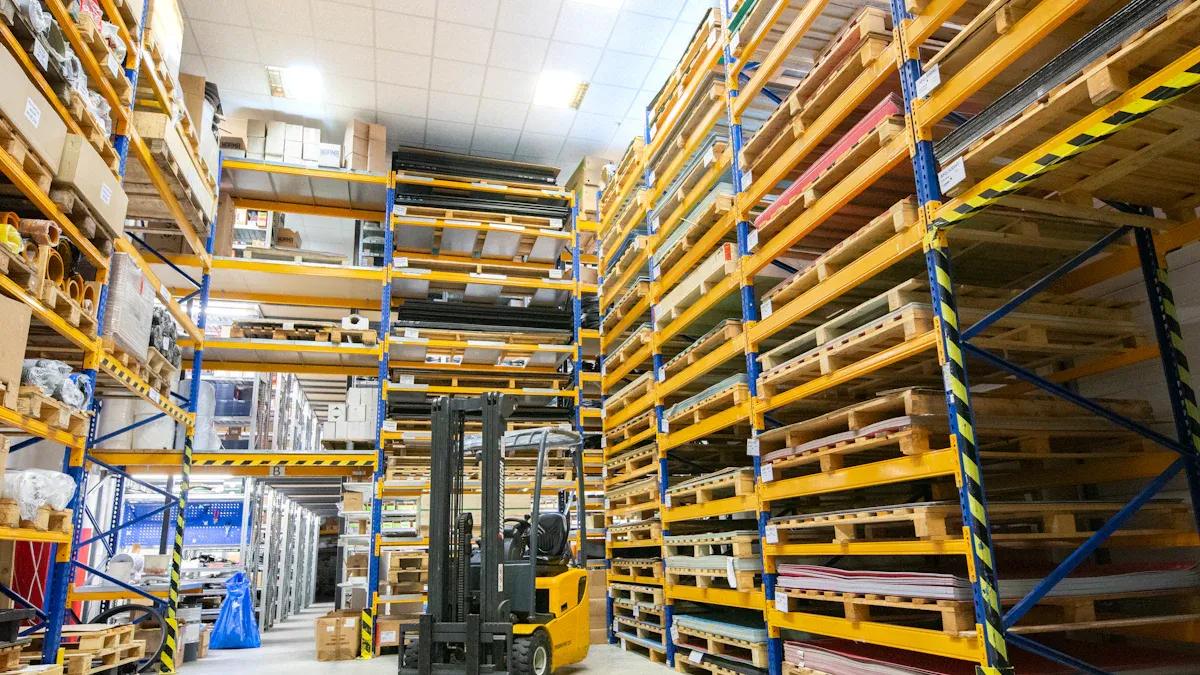How Dynamic Slotting Transforms Warehouse Operations

Dynamic slotting changes warehouse operations by placing products where they move fastest. This method helps teams pick orders quickly, lowers labor costs, and boosts accuracy. Companies see these benefits:
- Faster picking times
- Lower labor expenses
- Better order accuracy
- Greater adaptability to demand
Dynamic slotting supports warehouses as they grow and change. It gives managers the flexibility to meet customer needs every day.
Dynamic Slotting Overview

What Is Dynamic Slotting
Warehouse slotting refers to the process of organizing products within a warehouse to maximize efficiency. Teams use a slotting strategy to decide where each item should go. Traditional warehouse slotting often relies on fixed locations, but dynamic slotting changes this approach. In dynamic slotting, the system moves products to the best locations based on real-time data. This slotting strategy helps teams respond to changes in demand, product popularity, and order patterns.
Dynamic slotting uses advanced software to analyze sales trends, order frequency, and inventory levels. The system then updates the warehouse slotting plan automatically. Workers find popular items closer to packing stations, which reduces travel time. Less popular products move to less accessible areas. This planning method keeps the warehouse flexible and efficient.
Note: Dynamic slotting adapts to business needs. It supports fast order fulfillment and helps companies stay competitive.
Core Principles
A successful slotting strategy depends on several core principles. First, data-driven planning guides every decision. Teams collect information about product movement, order history, and seasonal trends. Second, continuous improvement shapes the strategy. Managers review performance and adjust the warehouse slotting plan as needed.
Third, flexibility stands at the center of dynamic slotting. The system must react quickly to new products, promotions, or changes in customer demand. Fourth, safety and accuracy matter. Good planning ensures that workers can pick items quickly without errors or accidents.
The right slotting strategy combines technology, data, and teamwork. Companies that follow these principles see better warehouse slotting results. They improve speed, reduce costs, and deliver orders with greater accuracy.
Warehouse Slotting Methods
Static vs. Dynamic Slotting
Warehouse slotting methods shape how teams organize products and manage space. Two main approaches exist: static slotting and dynamic slotting. Static slotting assigns each SKU a fixed location in the warehouse. This method rarely changes unless a full reorganization takes place. Teams using static slotting often face slow responses to market shifts. Manual intervention becomes necessary when demand changes or new products arrive.
Dynamic slotting, on the other hand, uses real-time data to adjust storage locations. The system tracks SKU velocity, turnover rates, and seasonality. High-demand items move closer to packing areas. Slow-moving products shift to less accessible spots. This warehouse slotting method improves picking efficiency and reduces travel time.
Static slotting works best for warehouses with few products and stable demand. Dynamic slotting fits operations that need flexibility and quick adaptation.
| Feature | Static Slotting | Dynamic Slotting |
|---|---|---|
| Location Assignment | Fixed | Continuously Adjusted |
| Response to Change | Slow, Manual | Fast, Automated |
| Best For | Stable Demand | Fluctuating Demand |
| Technology Needs | Low | High (WMS Required) |
Why Dynamic Slotting Wins
A modern warehouse slotting strategy must keep pace with changing business needs. Dynamic slotting stands out because it adapts quickly. This slotting strategy places popular items near packing stations, which speeds up order picking. Teams see fewer picking errors because the warehouse slotting plan groups similar items logically.
Dynamic slotting relies on advanced warehouse management systems. These systems monitor inventory and suggest the best slotting strategy for every product. As a result, warehouses use space more efficiently and avoid costly expansions. Managers can scale operations without major layout changes.
A flexible warehouse slotting strategy supports growth and seasonal peaks. It helps teams deliver accurate orders and meet customer expectations.
Warehouse slotting methods continue to evolve. Companies that invest in a dynamic slotting strategy gain a competitive edge. They improve efficiency, accuracy, and adaptability in every part of their operation.
How Dynamic Slotting Works
Data and Inputs
Dynamic slotting depends on accurate data. Teams collect information from many sources. These include sales history, order frequency, product dimensions, and inventory levels. Seasonal trends and promotional events also play a role. Managers use this data to understand which products move fastest and which items need special handling. The system updates information in real time, so every decision reflects the current state of the warehouse.
Reliable data forms the foundation for every slotting decision. Without it, the system cannot place products in the optimal location.
Algorithms in Action
Advanced algorithms drive the dynamic slotting process. These algorithms analyze changing factors such as demand spikes, new promotions, and shifts in customer order patterns. They use both historical and forecasted data to simulate different slotting scenarios. Warehouse management systems with AI and machine learning can recommend or even execute slotting changes automatically. The algorithms identify demand surges and adjust replenishment strategies, reducing the need for manual planning. They also adapt to new products and packaging, keeping the warehouse optimized at all times.
- Algorithms continuously analyze:
- Seasonal demand changes
- Promotional activities
- Customer order trends
- SKU size and packaging updates
- Inventory turnover rates
This approach ensures that products always move to the best possible locations for fast picking and efficient storage.
Real-Time Adjustments
Dynamic slotting stands out because it makes real-time adjustments. The system monitors warehouse activity and responds instantly to changes. When a product becomes popular, the system moves it closer to packing stations. If demand drops, the product shifts to a less accessible area. Managers see fewer bottlenecks and less congestion. Real-time updates help teams keep pace with customer needs and market trends. Advanced software and skilled management are essential for these rapid changes. Together, they ensure the warehouse operates at peak efficiency every day.
Optimized Warehouse Efficiency

Faster Picking
Dynamic slotting transforms how teams pick orders. The system places high-demand products closer to packing stations. Workers walk shorter distances to pick items. This approach increases pick velocity and reduces order cycle time. A major retail chain saw a 30% reduction in order cycle time after moving popular SKUs near shipping docks and grouping items often ordered together. This change led to less picker travel time and faster order fulfillment. Shorter travel distances also mean less worker fatigue and higher pick rates. Teams complete more picks per hour, which boosts overall productivity.
Dynamic slotting helps teams meet tight shipping deadlines and handle more orders each day.
Space Utilization
Optimized warehouse efficiency depends on better space utilization. Dynamic slotting uses real-time data to assign each SKU the best location. The system groups fast-moving products in prime spots and moves slow sellers to less accessible areas. This method ensures every shelf and bin serves a purpose. Teams avoid wasted space and reduce the need for costly expansions. Improved utilization allows warehouses to store more products without increasing their footprint. Managers see higher inventory density and smoother workflows.
- Key benefits of better space utilization:
- Maximizes storage capacity
- Reduces empty or underused areas
- Supports flexible inventory changes
Dynamic slotting keeps the warehouse organized and ready for growth.
Labor Cost Reduction
Labor efficiency improves when workers spend less time walking and searching for products. Dynamic slotting reduces unnecessary movement by placing items where pickers need them most. Teams finish tasks faster and require fewer overtime hours. Lower labor costs result from streamlined workflows and fewer errors. Managers can reassign staff to higher-value activities, such as quality checks or equipment maintenance. This shift leads to better warehouse performance and a more motivated workforce.
Companies that use dynamic slotting often report significant savings in labor expenses.
Improved Accuracy
Accurate order picking builds customer trust. Dynamic slotting groups similar products and separates items that look alike. This organization reduces picking mistakes and ensures the right products reach customers. The system updates slotting plans based on real-time inventory and order data. Workers follow clear paths and pick lists, which lowers the risk of errors. Improved accuracy leads to fewer returns and higher customer satisfaction.
- Improved accuracy also boosts key performance indicators:
- Higher shipping accuracy rates
- Fewer inventory discrepancies
Reduced Congestion
Warehouse congestion slows down picking and increases safety risks. Dynamic slotting spreads out high-traffic SKUs and balances workloads across zones. The system monitors activity and adjusts slotting to prevent bottlenecks. Workers move freely through aisles and complete picks without delays. Reduced congestion leads to safer working conditions and smoother operations. Teams maintain high productivity even during busy periods.
A well-organized warehouse supports faster picking, better space utilization, and safer workflows.
Real-World Results
Measurable Gains
Warehouses that adopt dynamic slotting see clear improvements in daily operations. Teams notice faster dock-to-stock times and less travel during putaway. High-velocity SKUs move to better locations, which leads to fewer replenishment moves and higher pick rates. Packing and staging become more efficient as products flow smoothly through the system.
- Labor productivity rises as workers spend less time walking and searching.
- Safety improves because congestion and ergonomic risks decrease.
- Product quality gets a boost since items face less damage and fewer picking errors.
- Service quality increases with fewer order delays and mistakes.
These gains help warehouses cut operating costs and increase throughput. Managers build operational excellence by using dynamic slotting to streamline every step.
Case Example: E-commerce
E-commerce companies face constant pressure to fill orders quickly and accurately. Dynamic slotting gives these businesses a strong advantage. Warehouse management systems analyze real-time data to adjust product locations. High-demand items move closer to picking and packing stations. Workers reach these products faster, which shortens order cycle times.
During busy sales events, dynamic slotting keeps operations smooth. Teams handle more orders without extra labor or space. The system adapts to changing demand, so popular products never slow down the process. E-commerce warehouses use this flexibility to meet customer expectations and stay ahead of competitors.
Case Example: Seasonal Peaks
Seasonal peaks test every warehouse. Demand can change overnight, and fixed slotting cannot keep up. Dynamic slotting solves this problem by moving products based on current trends. When a product becomes popular, the system places it in a prime spot. Workers pick these items quickly, even when order volumes spike.
- Dynamic slotting uses real-time data to respond to sudden changes.
- Space utilization improves as the system shifts inventory to match demand.
- Teams avoid bottlenecks and keep orders moving during the busiest times.
Warehouses that use dynamic slotting during seasonal peaks maintain high efficiency and deliver on time, no matter how much demand grows.
Optimized Warehouse Slotting Implementation
Technology Needs
Modern warehouse slotting depends on strong technology. Companies need slotting optimization software to manage data and make fast decisions. These tools connect with warehouse management systems to track inventory and product movement. The right software supports real-time updates and helps teams adjust quickly. Many businesses choose cloud-based solutions for easy access and updates. Reliable hardware, such as barcode scanners and mobile devices, also plays a key role in optimized warehouse slotting.
Tip: Start with a system that fits your current needs but can grow as your warehouse slotting requirements change.
Staff Training
Employees must understand new processes for warehouse slotting to succeed. Training programs should cover how to use slotting optimization software and follow new picking paths. Managers can use hands-on sessions and visual guides to help staff learn faster. Regular refreshers keep everyone up to date. When workers know the system, they make fewer mistakes and work more efficiently.
Best Practices
Successful planning starts with clear goals. Teams should review data often and update slotting rules as demand shifts. Leaders can set up regular meetings to discuss warehouse slotting performance. Using feedback from pickers helps improve the process. Companies should test changes on a small scale before rolling them out across the warehouse.
| Best Practice | Benefit |
|---|---|
| Review data weekly | Faster response to trends |
| Involve staff | Fewer errors |
| Test before scaling | Lower risk |
Overcoming Challenges
Some teams face resistance when switching to dynamic warehouse slotting. Clear communication helps everyone understand the benefits. Technical issues may slow down the process, but strong IT support solves most problems. Leaders should plan for extra training during the first weeks. Over time, teams see better results and adapt to the new system.
Note: Good planning and support make the transition to dynamic warehouse slotting smoother for everyone.
Dynamic slotting transforms warehouse operations. Teams see faster picking, lower labor costs, and better accuracy. Managers gain flexibility to meet changing demand.
- Evaluate current slotting methods
- Consult with warehouse experts
- Explore slotting software options
Dynamic slotting helps warehouses stay efficient and competitive. Companies that invest in this strategy build a strong foundation for future growth.
FAQ
What is the main benefit of dynamic slotting?
Dynamic slotting helps teams pick orders faster. The system places popular products near packing stations. This setup reduces walking time and boosts productivity.
Does dynamic slotting require special software?
Yes. Dynamic slotting depends on advanced warehouse management systems. These systems track inventory, analyze data, and suggest the best product locations.
Can dynamic slotting work in small warehouses?
Small warehouses can use dynamic slotting. The system adapts to any size. Even small teams see better picking speed and improved space use.
How often does the system update product locations?
The system updates product locations in real time or at set intervals. Managers choose the best schedule for their operation. Frequent updates keep the warehouse efficient.